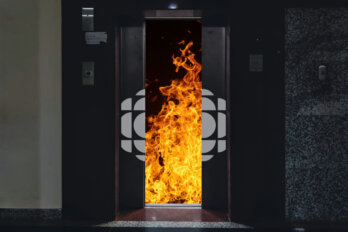Adapted from remarks delivered on March 16, 2015 at a gala event hosted by the journalistic alumni of Massey College in Toronto.
Earlier this month, I attended The Walrus Talks Creativity at Western University in London, Ontario. The speeches were fascinating. But an even greater highlight came during the reception, when I got a chance to speak to graduating members of the UWO journalism program. One by one, I asked them what they thought they would be doing this time next year. The answers painted a dispiriting portrait of my profession.
A few said they had a shot at legitimate journalism jobs—internships and contract positions at the London Free Press or local television affiliates. But the prevailing wages are low—about $18 to $20 an hour, they told me—and job security is non-existent. The possibility of landing a union-protected, middle-class staff position at a major media outlet is out of reach, at least for now. Some of the students I spoke to are thinking about skipping this game entirely, and heading straight to jobs in corporate communications and public relations.
The conversation became less depressing, however, when we began talking about the actual material these students are learning in their coursework. Yes, they’re taught old-school reporting skills, broadcast media, interview techniques, and research methods. But like other journalism school students I’ve met in recent years, they also know the full slew of electronic journalism, from social media to graphics to state-of-the-art content management systems. They know how to cover a story in many different ways—write, photograph, film, tweet—before calling it a day’s work. We bemoan the state of journalism. But in terms of providing media-industry employers with value for money, there’s never been a better-trained cohort of journalists.
Compare these people to oh, say, me. Back in 1998, the National Post hired me on as an editorial writer despite the fact that my job interview marked the first time I’d ever seen the inside of a newsroom. I liked writing, but had no journalism skills—as I demonstrated with numerous screw-ups in the first few months on the job.
Back in those days, employers had this crazy notion that they could just hire bright, ambitious people and train them over the course of a year or two. Eventually, that process worked for me. But this attitude is now totally obsolete—because money is scarce and patience with new employees is consequently thin. When I began hiring writers in the mid-2000s, the only people I interviewed were those who already had demonstrated their skill by writing for free on the blogosphere. They got their jobs by sending me web links, not resumés. These were journalists who I knew would hit the ground running on day one of their employment.
In those early years of the National Post, members of the editorial board came in to work in the morning, attended an editorial meeting, wrote a 300-to-400–word editorial, and went home. That was considered “work” in that era. And the same was true at other newspapers, as well.
By the time I left the Post in 2014, that was what you did before breakfast. Rank-and-file comment-section staffers are now expected to write multiple pieces per day, help out with editing, write headlines, browse freelance submissions, libel-check the comment threads, do radio and TV hits when necessary, and promote the hell out of themselves and their colleagues on social media. And even when it’s time to go home for the day, everyone’s expected to keep his or her smartphone on: you never knew when the media-party action is going to get good on Twitter.
It’s a lot of work for not much money. In 1998, I took a 30 percent pay cut when I left my job as a tax lawyer to become a journalist. These days, the equivalent pay cut would be more on the order of 75 percent.
Who’s going into this profession? I got myself into trouble for discussing this issue on Jesse Brown’s Canadaland podcast in early March. But I’m going to keep talking about it because a lack of diversity is a real problem in my industry, and it’s important to know what the roots of it are.
Because of the low salaries and poor job security offered by most journalistic employers, the industry has become less attractive to smart people who have other options—such as law, medicine, or business. This is especially true of people who come from impoverished or disadvantaged communities. If you can make $100,000 on Bay Street, why settle for a third of that at the Globe and Mail?
For some twenty-somethings, the answer to that question will be: a sense of creative fulfillment. And it’s true that writing is a fantastic way to earn a living. But the people who prioritize creative fulfillment over money and job security are disproportionately going to be the sons and daughters of privileged backgrounds—I freely offer myself as an example—who might not have to worry as much about where they’re going to get the mortgage money. Young adults from privileged backgrounds also are disproportionately more likely to be married to high-earning spouses. They can have one “artist” in the family and yet still pay the bills.
Age diversity also is a growing problem, in my opinion. When I began work in this industry in the late ’90s, it was still possible to imagine that you could get a job at a newspaper, earn a middle-class salary, buy a house in a major media centre such as Toronto or Montreal, and retire with a decent pension. That’s all but a pipe dream now for most aspiring writers. So those who do enter the profession often are young people looking for something interesting to do for a couple of years before heading off to do something else—law school, or the family business. Or they are older folks already grandfathered into the profession, or working freelance as retirees. The vast middle bulk of the workforce—thirty- and forty-something parents who rely on forty-hour workweeks to put food on the table for their kids—are slowly becoming an endangered species in journalistic circles.
As for the young people who do manage to get jobs at major media outlets, it is not just the increased workload and proliferation of media platforms they will have to deal with, but also the new way by which stories get assigned. In my day as a newspaperman, assignments were handed out more or less in the same way as they were in nineteenth-century Fleet Street offices: you pitched ideas, or ideas were pitched at you, and then a senior editor ultimately would tell you what to write. We had no scientific way of knowing what readers wanted to read, so we just figured that the editor with the biggest office knew best.
The Internet delivered us from our ignorance through the magic of the “hit counter.” Within minutes of posting an article to the web, you can get data about how many people are reading it, and what electronic avenues they are using to get to it (Twitter, Facebook, the outlet’s main portal, etc.). The editor in the corner office still gets to boss you around a lot of the time. But beginning about a decade ago, the hipster web editor from the digital offices also started getting a say, since he was the one who knew what was “trending.”
In the short term, surfing the hit counter is a great way for a young journalist to make a name for herself. But in the long run, it creates problems. When Rob Ford broke big, everyone wanted to write about Rob Ford. (At the height of the frenzy, twenty-two of the top twenty-five articles on the National Post’s most-popular reading list were Ford-related.) The system encourages the production of hastily written stuff, not all of it offering much in the way of news or insight.
The system also discourages beat reporting, which historically has been the best way for young writers to develop expertise and sources. That’s because whatever your beat—health care, banking, personal technology—there probably won’t be earth-shattering stories to report on every day. So editors are tempted to take you off beat, and throw you onto whatever is hot.
The other casualty of the hit-counter phenomenon is a decreased emphasis on investigative reporting, which is fantastically expensive and time consuming, but doesn’t always generate huge hits—although when it does, as the Rob Ford and Jian Ghomeshi case studies show, the results can be spectacular. Several media outlets have maintained a steady commitment to investigative reporting (I will single out the Toronto Star for excellence here, despite its embarrassing misfire on the recent Gardisil story) but the general trend has been a decline. If you can get 100,000 hits with an edgy opinion piece written by a twenty-five-year-old in an afternoon from her cubicle, why spend tens of thousands of dollars (much of it going to lawyers) on a second-tier, in-depth story that will get the same 100,000 hits? It’s not that Canadian editors don’t want to do the important, investigative stories; it’s that the economics don’t encourage them to do so.
People often ask me if newspapers are going to survive as print products. The short answer is yes. The luxury—and that is the right word in the digital era—of sitting down in a train or coffee shop with a professionally curated set of timely, attractively laid out stories about the world is an addictive pleasure. I’m certainly an addict: I subscribe to three print newspapers and an equal number of magazines. But consolidation will be necessary to ensure that the product quality is commensurate with the upscale tastes of the wealthy, well-educated consumers who increasingly will be the target market for print products.
Second-tier newspapers will go web only, or shut their doors. In the long term—ten years from now—I would not be surprised if Toronto’s three broadsheet newspapers effectively merged into one title; something that combines the brand of the Globe and Mail, the readability and say-anything punchiness of the National Post, and the investigative ethos, civic consciousness, and extensive local reporting network of the Toronto Star.
On the broadcast level, I expect to see the CBC eventually move away from their TV presence, and focus on its core strength: radio. For a variety of technological and cultural reasons that have been well documented elsewhere, TV is a dead end for public broadcasters. On the other hand, as long as people drive cars, cook food, and work boring jobs, there always will be a market for intelligent radio. By migrating assets in this way, the CBC may eventually produce radio on par with NPR or BBC—which it does not do now, despite being, by Canadian standards, the best game in town.
Finally, all elite media outlets need to do a better job leveraging their brands by creating affiliations with philanthropists, enlightened corporate partners, artists, and civic leaders. The Walrus Talks events offer an outstanding example of this, acting as an educational networking and entertainment hub for the sort of intelligent Canadians who are served by the magazine itself. In some cases, you are going to see media outlets turn themselves into outright non-profit entities that attract donors eager to encourage the creation of great journalistic work that cannot survive on traditional advertising. Examples include Mother Jones and ProPublica in the United States, and of course The Walrus here in Canada.
Journalists are are going to have to turn themselves into digital entrepreneurs, because, as my conversations at Western University show, you can’t just sit around waiting for someone to offer you a dream job anymore: the only way to carve out a living in this industry is to hustle on multiple fronts. Many of the young journalists I know combine freelance website work with spot radio and TV hosting, public speaking, and private communications consultancies.
There is money to be made in journalism these days, but more and more it comes in bits and pieces. For those with true talent, there still are just enough of them to build up something that, at the end of the month, looks something like a decent paycheque.




